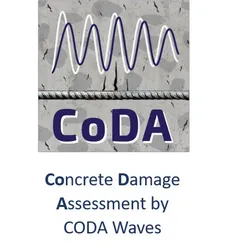Concrete Damage Assessment by Coda Waves
Person in charge: Eva Jägle, M.Sc.
Sponsor: DFG
https://www.mae.ed.tum.de/coda/
coda.bwp(at)ed.tum.de
Cost-efficient preservation of the integrity of the reinforced concrete infrastructure over the complete service life is of utmost importance, considering in particular, that modern RC structures have to meet increasing demands with regard to performance. Ultrasound based coda wave interferometry (CWI) is particularly suitable for the long-term assessment of reinforced concrete members.
The aim of the Research Unit Concrete Damage Assessment by Coda Waves (CoDA) is to develop and understand the coda technique as a tool for assessing the safety and durability of RC structures. Within the research unit, reaserchers at the Chair of Materials Science and Testing work closely together with researchers from the Ruhr University Bochum (Institute for Structural Mechanics and Institute of Concrete Structures), the International Geothermal Centre in Bochum, the German Federal Research Institute for Material Science and Testing (Division 8.2, Non-destructive Testing Methods for Civil Engineering) as well as from the Chair of Structural Analysis at the TUM.
Environmentally/mechanically caused Changes in Microstructure and their Effect on Coda Signals
The subproject „TUM1“ at the Chair of Materials Science and Testing aims at the experimental and data-based characterization of relationships between external loads and changes in the coda signal. The goal is to provide a spectrum of calibration curves and concrete-specific parameters by the end of the project to enable calibration and signal compensation of real engineering structures. To validate the causes of signal variations, changes in concrete microstructure will be characterized using conventional and innovative techniques. The relationships between impacts and microstructural changes, as well as the corresponding analysis and interpretation of the coda signals, provide important input parameters for modelling wave propagation, material properties, and structural changes, as developed in other individual projects of this research group.

In the first funding period (2019-2022), the influence of uniaxial compressive and tensile loads as well as temperature and moisture variations on the coda signal was investigated in controlled laboratory experiments on concrete specimens.
In the second phase (2022-2025), the relationships derived in the first phase through one-dimensional experiments will be systematically extended to include additional influences, such as the surface condition. Furthermore, following the characterization of homogeneous states, moisture and temperature gradients relevant to practice will now be investigated. The second funding phase will also focus on concrete-specific long-term phenomena such as carbonation and frost attack. Special attention will be paid to the distinction between reversible and irreversible microstructural changes. The investigated material changes will be specified through selected methods, such as computed tomography or thin-section microscopy.
